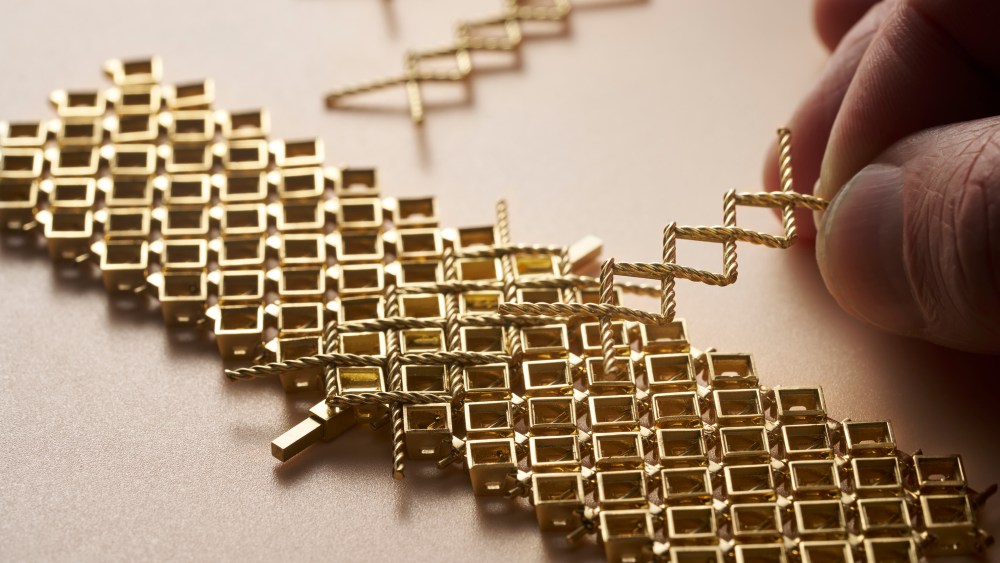PARIS – What’s a milestone celebration without some jewelry?
After watches, Piaget is bringing out its best jewels with the “Essence of Extraleganza” high jewelry collection, which will be the highlight of a week-long exhibition at Palais Brogniart starting Tuesday.
Open to the public by appointment from Thursday to Sunday, the exhibition will head to Shanghai in September and Seoul in November.
For Piaget’s artistic director Stéphanie Sivrière, imagining a collection for the house’s 150th anniversary was about diving into its patrimony to get a sense of the strongest currents that underpinned its creative development.
Through the 96-piece collection, with more than 40 of them presented in Paris, Sivrière would like visitors to take away that Piaget is “a jeweler and a watchmaker unlike others, particularly through our work on materials.”
You May Also Like
“What I leaned into was the know-how of the house, particularly those that were a little forgotten like chain-making or mesh, but also the work on hard stones, gold braiding — and timekeeping jewels,” she said.
An era that embodied this spirit in Sivrière’s opinion is the cusp of the 1970s. According to the creative, “1969 was a particular highlight for the house where daring and freedom jewelry watches peaked, so I really centered there.”
They therefore take pride of place in the anniversary collection.
Among the key pieces in the collection is an emerald-set cuff watch bracelet. Some 200 elements have been assembled and hand-adjusted on a twisted mesh bracelet that houses 36 baguette-cut eye-clean Colombian emeralds totaling over 26 carats. Its price is said to be above the 2 million euros mark, making one of the most expensive pieces in the collection.
She also made multiple wears into a talking point.
Case in point: a Swinging Sautoir with a twisted gold chain carrying fringes of malachite and turquoise beads. The 29-carat cushion-cut Sri Lankan yellow sapphire and 6-carat aquamarine lead to a watch, which can be detached and placed on a bracelet to become a precious wrist ornament.
“I enjoy giving the client different ways of wearing [pieces]. It’s rather nice — and makes it easier to sell — because it gives a second life to the pieces depending on the mood, the style of the event,” she said. “Since we are a watchmaker and a jeweler, having a watch that turns into a jewel and vice-versa is always a good way to embrace that.”
Jewels that don’t tell time are also well represented.
Standing out is a necklace shaped like a radiating collar made of rows of engraved Decor Palace engraving, set with 30 carats’ worth of round Colombian emeralds, a rather rare cut for this gem.
A necklace styled like a rope with gold pompoms, featuring 1,300 cabochon turquoise, was another highlight. “It’s crazy in terms of work because everything is supple but made of twisted gold,” Sivrière said. “It was a technical prowess to put that in place and keep the movement.”
Chief executive officer Benjamin Comar lauded Sivrière’s knack for “making a product magical. She pushes aesthetic boundaries and she doesn’t stay locked in with technique.”
While others may be looking toward new materials for their high jewelry, the focus at Piaget remains on fluidity and ensuring materials are at their best while ensuring comfort and wearability. “Between gold and stones, we already have many interesting things to do,” he continued. “We aren’t necessarily on a quest for innovation in terms of materials but in terms of know-how.”
In choosing Paris, the brand intended an homage to Piaget’s connection to the French capital, said Comar.
“It’s rather ancient because in the time of Valentin Piaget, he’d send his illustrators to Paris during fashion week to be inspired,” the executive explained. “For a small brand of jewelry and watchmaking based in Switzerland’s La-Côte-Aux-Fées, it was rather incredible. I’m not even sure the Place Vendôme houses went to the shows that were 30 meters from their offices at the time.
“What we wanted to express in this anniversary year is the continuity between Piaget’s creativity [today] and its past creativity,” he continued.
Asked what draws clients to Piaget today, Comar said that those he saw were “happy to find this modernized, not nostalgic” take on the house. “They are happy to see and find once more what they imagined Piaget to be but, in such times, what they want is to see what is specific about Piaget,” he continued. “We are focused on our culture, our heritage and the idea that it’s a living patrimony, not reeditions of old designs.”
As jewelers put on ever-more glamorous displays, the onus is on brands to bring something new to the table — and not just in terms of designs, according to the executive. “It’s part of our cultural role towards clients, partners and the press,” he added.
Even more so when competition is fierce and players numerous, in addition to an economic environment that invites caution.
“The fact that there are more buyers creates desire, visibility for the category and gets even more people interested,” he said. “It’s healthy competition and there’s emulation to make even more creative, even more distinctive, even more interesting pieces.”
According to the executive, Piaget has a sizable Asian and Middle Eastern high jewelry clientele and has begun seducing Americans and a few European customers too.
And unlike other categories, high jewelry clients could not really be analyzed by segments. “They’re above all a community that has more in common with each other through their travels, their artistic interests, their style than with people of their age category or nationality,” he said.
But rather than highlight the “Essence of Extraleganza” by itself, the brand staged its reveal in dialogue with archival designs and pieces from private collections.

For Fatemeh Laleh, Piaget’s global communication and image director, immersing visitors in the designs through a circuit that takes them through a succession of stages beginning with its House of Gold identity and ending with the Piaget Society and the latest campaign featuring Ella Richards photographed by Brigitte Niedermayer was essential.
“It’s a mise en abyme for this new collection, with the continuity of the style, the signature, the past, the present,” she said. “It gives context to why you fell in love with this necklace or that cuff. And that’s also a way of celebrating 150 years’ worth of know-how.”



